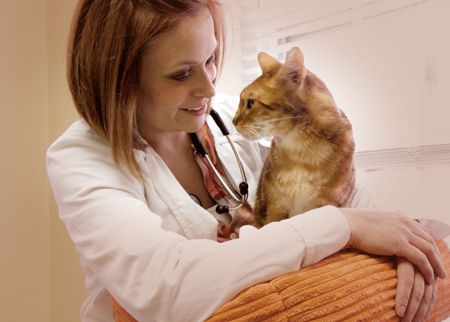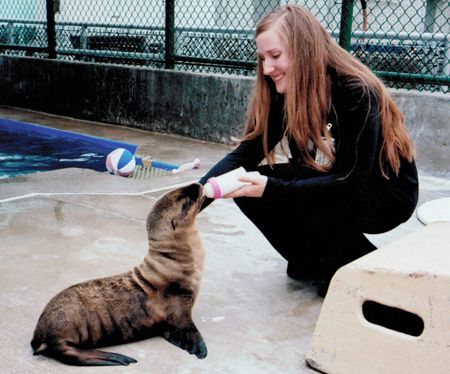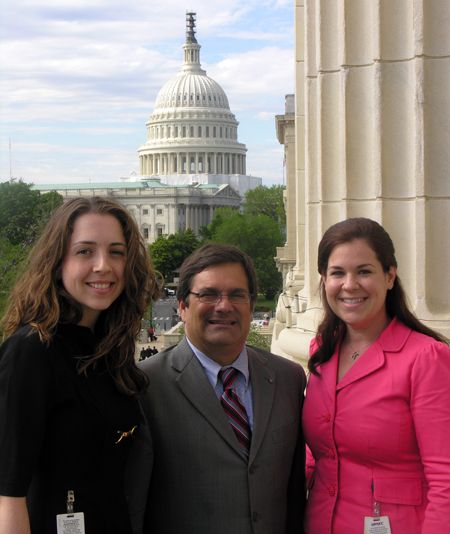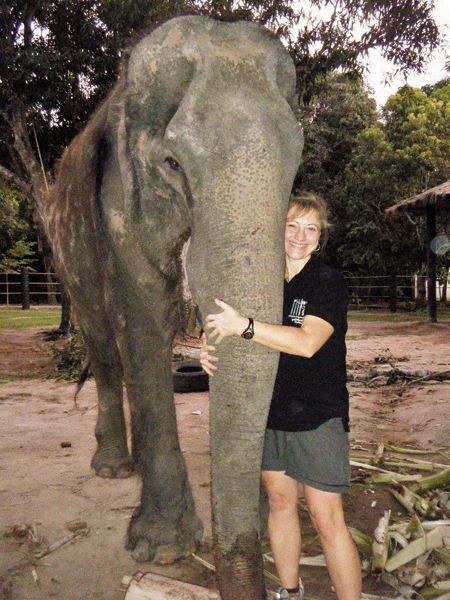The service spectrum: Exploring the dazzling array of ways to use a veterinary degree
Think private practice is the only way to use a veterinary degree? Dont be so black and white! Todays veterinarian faces a rainbow of choices when it comes to using a veterinary degreeincluding new ways of meeting pet owners needs in private practice.

Getty ImagesPicture, if you will, one of the most common stereotypes in veterinary medicine. A young girl, bright-eyed and optimistic, decides by her seventh birthday that she will be a veterinarian. She works hard, gets her degree and lives happily ever after. This is what most people imagine about our lives if given the opportunity-and sometimes it goes just like that.

But what about everyone else? What about those who find themselves derailed from that course by family, debt, burnout and ennui? What about the veterinarians who can't figure out how they want to serve pet owners or animals because the “old way” just doesn't do it for them? There are plenty of those too. Often these veterinarians continue to slog through unrewarding jobs simply because they don't see any other options.

As veterinary medicine evolves, so do the needs of pet owners, the planet and veterinarians themselves. Opportunities for diverse careers are coming to the forefront as veterinarians look for alternative uses for their degree-and alternative visions for what practice looks like.
Veterinarians are finding all sorts of ways to put their degrees to good use. Some do it by design, others by luck, and some just head into the world to see what happens. Here's how they're reinventing the profession.
The visionary: Christine Meredith, VMD
More than in any other generation, the veterinary road less traveled has become practice ownership. Christine Meredith, VMD, has been down the road twice. First, out of school, she bought a high-functioning practice from a retiring veterinarian in North Carolina and enjoyed a few years of happy if emotional practice. “When I was young, I let things ruffle my feathers a lot easier,” she says.

Dr. Christine Meredith wanted to create an "elevated experience" for pet owners and employees in her practice. (Photo courtesy of Dr. Christine Meredith.)Eventually she moved back to Pennsylvania (she was born in Scranton) and bought a “jump-start” practice, one beat up and left to wind down by another practice owner. What would become Affinity Veterinary Center of Malvern, Pennsylvania, had just 100 clients when Meredith took over. There were three other practices in a five-mile radius.
But Meredith thought the old Chester County farmhouse was the perfect place to create an “elevated experience” for both pet owners and her employees. This time she put to work all the ideas she and her husband (Travis Meredith, also a DVM, who has a love for business and marketing) had for keeping out the staff drama and bringing in an experience that was client-focused and parent-focused-in other words, people-focused.
The farmhouse was prettied up. The homey reception area was filled with Ikea furniture, easily replaceable if patients and clients scuffed and beat it up. But that doesn't even happen often since clients who come in the front door almost always head straight to an exam room.
In addition, “there's a lot of hand-holding through procedures and decision-making” in the practice, Meredith says. She's available seven days a week by email. Clients get it: “They understand and appreciate and respect our pricing structure, and I get few complaints about price per year,” she says.
Meredith's biggest difficulty has been finding new people who fit her focused, unified team. She cultivates patience in herself to take time to find team members with skills other hospitals might skimp on.
“I focus more on care, compassion, communication skills and patience,” she says, “that ability to go into an exam room and find a point of commonality with a client and express their cares and concerns, to show animals they can trust you, thereby showing the owners we're conscientious and caring.”
Potential veterinary team members who'd “rather stay in the back and do procedures,” she says, are weeded out during initial interviews.
Meredith's no-nonsense attitude to focusing completely on clients is mirrored perfectly in her high expectations for professionalism, adult behavior and camaraderie.
“We do not hold grudges,” she says. “If you have a child who's sick, someone will cover for you. And next time, you know you'll cover someone else. And if you can't do it that time, no one is going to hold it over your head. There's zero tolerance for holding things against others.”
Meredith and her husband toy with the idea of marketing this farmhouse look and feel in other locations, but she hesitates: “I don't know that we can. We are marketing a feeling. That's a difficult thing to do.”

Meredith established her practice in a prettied-up farmhouse in Chester County, Pennsylvania. (Photo courtesy of Dr. Christine Meredith.)
The road of veterinary practice ownership will continue to be the road less traveled. But doctors like Christine Meredith make us wonder whether a new generation of transparent, smart, client-focused-and, yes, female-veterinarians could keep the future of veterinary medicine always and forever in the hands of visionary entrepreneurial doctors.
The researcher: Sarah LaMere, DVM, PhD
Sarah LaMere, DVM, PhD, is not necessarily addicted to school-she just enjoys too many things to manage with just one graduate degree. LaMere developed an interest in science research while she was an undergraduate pre-vet student at Texas A&M, and it never quite went away.

Dr. Sarah LaMere, whose research career has involved work at Sea World and the San Diego Zoo conservation institute, tends to a sea lion patient. (Photo courtesy of Dr. Sarah LaMere.)“I hadn't decided when I graduated what I was going to do,” LaMere says. “It was on my radar to possibly do a PhD, but I wasn't necessarily planning on focusing my career on research. Clinical medicine was still something I wanted to do. I didn't envision myself being solely an academic.”
During breaks LaMere took advantage of the time to pursue research. One summer she applied for a pathology internship at Sea World in San Diego to study a virus found in orcas. After graduation she received additional funding to complete the project as a collaborative effort between the veterinary pathologists at the San Diego Zoo's Institute for Conservation Research and Sea World. During what little time off she had, she worked part time in veterinary clinics and volunteered with Mexico's Humane Society de Tijuana, just across the San Diego border.
Over the course of the orca project, LaMere consulted with HIV researchers at University of California-San Diego and the Scripps Research Institute. Their research into porcine viruses of zoonotic concern paralleled her own work, and she found herself drawn in.
“By that point,” she says, “I decided I needed to do a PhD.”
The next phase had begun. LaMere completed her doctorate in immunology in 2015, eight years after completing her veterinary degree.
“Looking back, I didn't really appreciate how hard it was going to be,” LaMere says. So how hard was it? Her thesis focused on epigenetic mechanisms in CD4 T cell activation and memory formation, with wide applications across many species.
What a relief! Living the locum tenens life
A number of veterinarians have ditched regular practice life. Could relief work be the answer to the horrible stress, miserable work-life balance and self-doubt pervasive in the industry-at least for some? Read the confessions of those who've made the switch at dvm360.com/reliefconfessions.
Despite a grueling and sometimes erratic schedule working in the lab, LaMere was determined to use her DVM degree as well, not only to keep up her clinical skills, but also to help with her student loan debt. She started doing vaccine clinics on weekends and eventually started working with a home hospice and euthanasia practice. “I do enjoy it,” she says. “I like the hospice aspect of it. It's very gratifying.”
LaMere recently signed on as a postdoctoral fellow at the University of California, San Diego, School of Medicine Center for AIDS Research. While she studies HIV latency, she hopes to apply that knowledge to species such as orcas and koalas. In koalas, a retrovirus that has jumped into the genome-a process known as endogenizing-is thought to be associated with the development of leukemia and lymphoma, much like FeLV in felines. Research in one species often leads to breakthroughs in others, an idea that continues to motivate LaMere. She envisions an eventual role in academia as an assistant professor, which will allow her to continue her research.
“There was a lot of serendipity in where I ended up,” LaMere says. “It seems like every time I tried something else, I got thrown back into research.”
She sees the small number of veterinarians who are involved in comparative medicine as an opportunity rather than a hindrance to her chosen path. “There's a need for it,” she says. “This whole One Health idea is just now becoming popular, but we [veterinarians] have been doing it for decades.”
The public health pro: Ellen Carlin, DVM
“I never intended to become a traditional private practice veterinarian,” begins Ellen Carlin, DVM. And she kept her word.
“I went to vet school with an interest in public health-infectious diseases and zoonotic diseases specifically. I liked the big picture of epidemiology and working with animals,” Carlin says.
As she continued her studies, she learned that pursuing a career in public health “would be tricky” without another advanced degree. But going from four years of veterinary school straight into a graduate degree wasn't realistic. “I couldn't do that,” she says. “I wanted to become part of the working world.”
Seeking an alternative pathway, Carlin applied for an AVMA Governmental Relations externship, a four-week program that lets veterinary students work with legislators and staffers on Capitol Hill. The natural next step for Carlin was the AVMA Congressional Fellowship, a one-year opportunity to serve in Washington, D.C., as a scientific advisor to members of Congress.

Carlin (left) with Florida Rep. Gus Bilirakis and colleague Kerry Kinirons in April 2012 outside the House Committee on Homeland Security hearing room after a biodefense hearing on medical countermeasures. (Photo courtesy of Dr. Ellen Carlin.)The fellowship fell under the larger umbrella of the American Association for the Advancement of Sciences (AAAS), a scientific society that exposed Carlin to a wider variety of medical professionals and scientists with similar interests.
“It's a great opportunity for scientists, engineers and doctors to take a year break and get a different perspective on different ways to use their expertise,” she says. “There's people just out of school or mid-career. It's a melting pot of different ages and careers.”
At the end of the year, Carlin took a position in D.C. with the House of Representatives and the committee on Homeland Security. “There was a lot I could provide to them with a scientific background in infectious diseases,” she says.
She remained in Washington, D.C., until 2013, when she decided it was time to move on. “It was an interesting place to be for someone who is relatively apolitical,” Carlin says. “But the number of positions for veterinarians is relatively limited.”
She turned her eye from policy back to science. Her next move was a fellowship with the Oak Ridge Institute for Science and Education, a Department of Energy institute that provides opportunities for scientists to collaborate with a wide variety of government, industry and academic institutions. Carlin was placed with the U.S. Food and Drug Administration's Center for Veterinary Medicine, spending a year working on antimicrobial resistance.
Looking into the Centers for Disease Control's Epidemic Intelligence Service as well as positions in academia, Carlin was reminded of the limitations she faced without an additional graduate degree. Undaunted, she launched her own consulting business. “It wasn't meant to be a permanent position,” she says, “but…” She trails off and laughs.
While working in consulting means she is continually looking to acquire the next project, she also enjoys the variety of jobs. She's co-director of the Blue Ribbon Study Panel on Biodefense, advocating for improving the nation's biodefense by providing her veterinary perspective. Carlin recently travelled to Guinea with George Washington University to advise the government on how to improve policies on zoonotic disease. Next up is advising a national laboratory on business development.
“I've learned over the years there are people who had their eye on the ball and went straight for their goal, then there's the rest of us,” she says. “Life is a bowl of cherries, and you want to experience it all.”
The one who did it all: Teri Weronko, DVM
Teri Weronko, DVM, is on the move. She just moved into a new house in St. Kitts, and after her interview with dvm360 she needed to book a flight to Thailand for an upcoming trip to an elephant sanctuary. Before coming to St. Kitts, she had been sailing in France.

Dr. Teri Weronko visits elephant sanctuaries in her work with World Vets, an international veterinary organization that provides humanitarian aid. (Photo courtesy of Dr. Teri Weronko.)But her life didn't always look this way. Until a recent life change shook her up, she had followed the more traditional timeline of veterinarians in small animal practice.
For the first eight years after graduation, Weronko worked in emergency medicine. Her husband suggested buying a practice, so they converted a home in Washington state into a practice and lived in the nearby garage.
“Our six-week renovation turned into six years,” she says.
She remained at that practice for 16 years, while volunteering on the side to keep things interesting.
“I was the head vet for a local zoo and did a lot of volunteer work there,” she says. “I also did rescue work for our local disaster response.”
Weronko decided it was time to sell the practice right at the time the recession hit. Compounding the stress, her marriage ended in divorce. Weronko started working with World Vets, leaving on international trips for 10 days at a time, and found those little breaks kept her spirits up during a rocky period. It took two years to find a buyer for her practice, and by then Weronko felt completely burned out.
“I was thrown kicking and screaming out of my nest by my divorce, but once this thing happened, I could stand back and ask myself what I wanted to do,” she says. “Because I was miserable, I had to sit back and say, ‘What will make me happy?'
She found herself thinking again and again about the World Vets trips.
“They made me feel good again, and I needed to do things that made me feel good,” she says. “It was about getting excited again.”
Weronko took a two-year sabbatical, living off the proceeds from the practice sale. She worried that she wasn't putting money away for retirement, but the tradeoff in terms of her attitude toward life and the profession was well worth it, she says. As a trip leader for World Vets, she rode horses in Mongolia, assisted flood victims in Thailand and treated donkeys in Tanzania. She spent six months in France learning to sail.
“That whole period changed my view of what we go into practice for,” she says. “We go in to save animals, but it's not really what it turns out to be.”
At the end of her sabbatical, Weronko returned to Washington and worked as a relief veterinarian, finding success and fulfillment with her new positive attitude.
Then a call from Ross University came: “I had applied for work there a few times. I told them I wanted to try teaching as a career move and also be in a position to share this idea I had about how to protect your spirit: Don't give it all up to try and make money. It's a dangerous slope to not love your life.”
These are just a few of the many veterinarians who are forging their own path in a surprisingly diverse field of work. Sometimes all it takes is the realization that other options are out there for people to change their perspective. With that in mind, see this article for a list some of the expected, and not-so-expected, uses for a degree in veterinary medicine. Some are paid, some are volunteer, and some are tongue-in-cheek, but they're all in play as we speak.
Weronko just began a three-year position at Ross University teaching students clinical medicine and, even more important to her, coping skills for long and fulfilling careers. “I meet myself over and over again at conferences, people scared to leave situations because of finances,” she says. “It's about finding a way to serve. It's about making sure that I feel fulfilled, that the work feels useful.” And with that, she's off to the beach with her dog.
Dr. Jessica Vogelsang, a certified veterinary journalist, is a regular contributing writer for a number of publications, author of the memoir All Dogs Go to Kevin and creator of the popular blog Pawcurious.com.
Brendan Howard is Business Channel Director for dvm360.com.